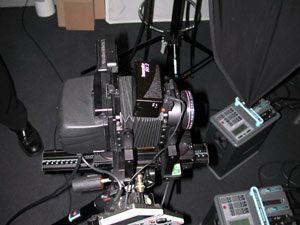Rollei and Rolleiflex, Franke & Heidecke, respected names in the history of medium format 2 1/4 inch photography.
 Rollei medium format CameraMy first medium format camera was a Rolliflex. All the excavators of the University of Pennsylvania's archaeology project at Tikal, Guatemala, had the venerable twin-lens Rolliflex available. This was back in 1965, when I was a student at Harvard taking a year off from college. Taking a year off from college was sort of a ritual in these years of the do-your-own-thing movement which ravaged higher education.
Rollei medium format CameraMy first medium format camera was a Rolliflex. All the excavators of the University of Pennsylvania's archaeology project at Tikal, Guatemala, had the venerable twin-lens Rolliflex available. This was back in 1965, when I was a student at Harvard taking a year off from college. Taking a year off from college was sort of a ritual in these years of the do-your-own-thing movement which ravaged higher education.
But when it came time for me to buy my first professional camera for archaeological recording, I was already under the influence of the Hasselblad myth, initiated by the infamous movie Blowup, and nurtured by the use of Hasselblad as the preferred camera of American astronauts on the moon. I have had five Hasselblad cameras over the years and have enjoyed several decades with them.
But when I look at the Rollei catalogs and see what Rollei has to offer, I realize that without the publicity of the topless scene in Blowup, and without the allure of having a camera that proved itself in Outer Space, that the success story could equally well have been Rollei. I would add that the first Bronica I saw, also at the archaeological project of Tikal, was a clunker. Bronica is one camera that has not really outgrown its earlier (poor) reputation. But back to Rollei.
Rollei uses the virtually identical Zeiss lenses, as does Hasseblad. But better, Rollei has the Schneider family of lenses available. The 90 mm Schneider Apo-Symmar is a universal macro lens with apochromatic correction. Other lenses do not focus in the same plane in each of the three colors (Red, Blue, Green). This fact is painfully evident in digital photography since your computer can focus your lens on each color independently. This allows you to see how far the colors are off (based on tests reported by Michael Collette, Better Light).
On the subject of how you need to upgrade your lenses as you enter the digital era, be sure to get the 150 mm Apo-Symmar PQ f/4.6 Makro. This would probably be a good lens to try out for the Seitz Super Roundshot. The Seitz system (not to be confused with Leitz) uses either Hasselblad mounts or Rollei mounts.
If you like to do nature photography, the 140-280 mm Schneider Variogon PQ f/5.6 HFT is ideal. This sure surpasses the quality and ease of use of any lens I have (and I have tons).
I feel that Rollei makes a solid product that deserves to stay in the ranks of the great medium format cameras of professional quality. A few clever innovations and they cannot only survive, they can regain lost market share.
All the photographs of Tikal temples and palaces on our www.maya-archaeology.org website were taken with a Hasselblad, but that is only because I got locked into the Hasselblad myth decades ago. If I had a Rollei system this Web site would really be a feast for your eyes.
Now that Contax and Bronica both failed in the marketplace, we hope that this does not happen to Rollei or Franke & Heidecke. But to survive in the digital era (in medium format), their Rollei X-Act 2 will need to excel against the Horseman clone and against the Linhof 679cc.
The Rollei 6008 AF is the highest pro standard if you wish to shoot square format film, 645 format film, and medium format digital interchangeably. But if like so many pro photographers today you are abandoning film for the increasing benefits of digital capture, then this will call for auto-focus on the 6008. No digital sensor is large enough to take advantage of the full 6x6 cm format of a full-sized medium format camera.
Most recently updated February 27, 2006.
First posted Feb. 25, 1999. Updated Aug 12, 2005.